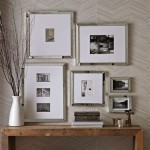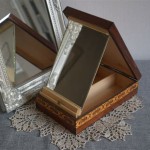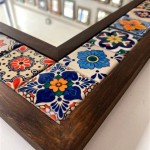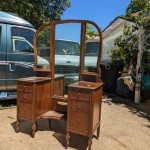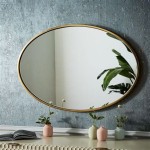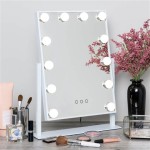How to Attach a Mirror to the Wall
Hanging a mirror on the wall can dramatically enhance a room's aesthetics and functionality. However, it's crucial to ensure the mirror is secured properly to prevent accidents and damage. This article outlines various methods for attaching mirrors to walls, covering different mirror types and wall materials.
1. Assessing the Mirror and Wall
Before beginning the installation process, careful assessment of both the mirror and the wall is essential. This involves determining the weight and size of the mirror. Heavier mirrors will require more robust hanging methods. Examine the back of the mirror for existing hardware like D-rings, wire, or cleats. This will influence the chosen hanging method.
Next, determine the wall type. Drywall is the most common, but other possibilities include plaster, concrete, and brick. Each material requires a specific type of fastener. It is also vital to locate wall studs using a stud finder. Hanging heavy mirrors directly on drywall without hitting a stud is not recommended. Studs provide a more secure anchor point.
Finally, consider the desired location and height of the mirror. Ensure the chosen location can support the mirror's weight and that the height is suitable for its intended purpose.
2. Choosing the Right Hanging Hardware
The appropriate hanging hardware depends on the mirror's weight and the wall material. For lightweight mirrors on drywall, specialized mirror clips or adhesive strips may suffice. Heavier mirrors will likely require screws and wall anchors, especially if not being mounted directly to studs.
Several types of wall anchors exist, each designed for different weight capacities and wall materials. Plastic expansion anchors are suitable for lighter loads in drywall. Molly bolts offer greater holding power in drywall or hollow walls. Toggle bolts are ideal for heavier mirrors in hollow walls, providing a very strong anchor. For concrete or brick walls, concrete screws or masonry anchors are necessary.
When choosing screws, ensure they are long enough to penetrate the wall securely and of an appropriate gauge (thickness) to handle the mirror's weight. Using screws that are too short or thin can result in the mirror falling, potentially causing injury and property damage.
3. Utilizing Different Hanging Methods
Several methods can be employed to attach a mirror to a wall. For lightweight mirrors, adhesive strips designed specifically for mirrors can provide a quick and easy solution. Ensure the wall surface is clean and dry before applying the strips. Follow the manufacturer's instructions regarding weight limits and application procedures.
For mirrors with D-rings or wire, heavy-duty picture hangers with appropriate weight ratings can be used. Locate the studs in the wall and mark the desired locations for the hangers. Drive the hangers into the studs using a hammer, ensuring they are securely fastened. Then, hang the mirror on the hooks of the picture hangers.
For exceptionally heavy mirrors or when hanging on walls without studs, J-channels or French cleats provide a more secure mounting solution. A J-channel is a metal track attached to the wall. The mirror then slides into the track, providing a secure grip. French cleats consist of two interlocking pieces of wood, one attached to the wall and the other to the back of the mirror. The two pieces interlock, creating a strong, stable connection.
Another method involves using mirror clips. These clips are typically screwed into the wall and then grip the edges of the mirror. They offer a discreet and secure way to mount mirrors, especially thinner, frameless ones. Ensure the clips are appropriately sized for the mirror's thickness and weight.
Regardless of the chosen method, always double-check the weight limits of the hardware and ensure they are suitable for both the mirror and the wall material. Proper installation will prevent accidents and ensure the mirror remains securely mounted for years to come.
Safety precautions should always be taken during the installation process. Use appropriate personal protective equipment such as safety glasses and gloves. If using power tools, follow all manufacturer safety guidelines. If working with exceptionally heavy mirrors, enlist the help of another person to prevent accidents and ensure proper placement.
4. Post-Installation Checks
After the mirror is hung, perform a final inspection. Gently tug on the mirror to ensure it is securely attached. Check for any wobbling or instability. If the mirror feels loose, re-evaluate the hanging method and hardware used. Consider using a stronger anchor or a different hanging technique. Ensure the mirror is level and hangs straight on the wall. Minor adjustments can be made by using shims behind the mirror or adjusting the hanging hardware.

How To Hang A Frameless Mirror On The Wall With Pictures

How To Hang A Large Or Heavy Mirror
How To Hang A Heavy Mirror On Drywall Without Damaging It Or The Wall Quora

3 Simple Ways To Hang A Mirror On Wall Without Nails Wikihow

How To Hang A Heavy Full Length Leaner Mirror On The Wall House Of Hepworths

How To Hang A Heavy Mirror The Home Depot
:strip_icc()/ScreenShot2022-04-28at1.12.19PM-e055476c70c6438585fa7c5cd531edcf.png?strip=all)
4 Easy Ways To Hang A Heavy Mirror

How To Hang A Frameless Mirror On The Wall With Pictures

How To Hang A Frameless Mirror On Wall

How To Hang A Heavy Full Length Leaner Mirror On The Wall Hanging Over Door Mirrors

